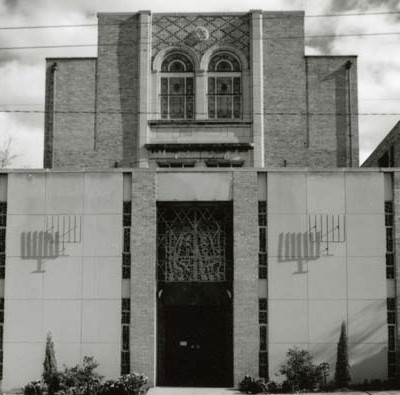
New Kensington was founded in 1891, when the Burrell Improvement Company purchased land along the Allegheny River north of Pittsburgh, laid out a town and held a highly publicized sale for lots. Among the early purchasers was the Pittsburgh Reduction Company, which became the Aluminum Corporation of America, or ALCOA. New Kensington was incorporated as a borough in 1892.
The first Jewish settler in New Kensington arrived during the initial sale. A peddler named Isaac Claster purchased one of the lots and built a clothing store on Tenth Street in 1892. Others soon followed. The brothers Isaac and Phillips Fisher opened a store in New Kensington in 1893. In 1894, David Solobodsky opened a cigar factory and Harris N. Miller started working as a tinner and a grocer. He became the first Jewish groom in New Kensington when he married Mary Rosenberg on Pittsburgh a few months after arriving.
These and other Jewish families held their first religious services in 1895, when Rabbi Herman Levendorf read the megilah at the Claster home on the evening of Purim. Over the next decade, the group held services in various rented rooms downtown, including a hall over Bloser’s Jewelry Store on Fourth Avenue, the second floor of a building at Fourth Avenue and Tenth Street and the storeroom of a building on Third Avenue. By 1905, the Jewish community included about 25 families and could no longer fit in rented rooms. They founded a small synagogue that year in the 1100 block of Third Avenue.
The group incorporated Beth Jacob Congregation in May 1907. Its initial directors were Isaac Fisher, Isaac Claster, David Solobodsky, Harry Simon and Peter Richest. Other charter members were L. Sahn, D. Miller, T. Myers, H. Kipelman, H. N. Miller, Simon Steiner, Jacob Sakulsky, Moritz Hershovitz, Morris Miller and Harry Kubrin.
Beth Jacob Congregation grew quickly over the following decade, as more families moved to the borough and as Jewish families in nearby Tarentum and Natrona used New Kensington as a central meeting place for worship, education and social activities.
B’nai B’rith Lodge No. 657 and a competing fraternal organization called the Independent Order of the Sons of David Lodge No. 10 were both founded in 1910. The community appears to have been home to at least two other B’nai B’rith lodges.
The community chartered the Chevra Kadisha Cemetery Association in 1911. The first burial occurred in 1913. Martha Horwitz founded the first religious school in 1912 with five students. The school held its first confirmation ceremony in 1920. New Kensington was also home to a variety of youth groups during these early years, most notably a Young Men’s Hebrew Association and an associated ladies auxiliary, founded in 1915.
The Jewish population of New Kensington increased steadily through the first four decades of the 20th century. The American Jewish Yearbook listed a population of 375 in its 1918-1919 edition, 640 in its 1928-1929 edition and 735 in its 1940-1941 edition. As the congregation outgrew the Third Avenue Synagogue, Beth Jacob purchased a residence on Kenneth Avenue to use for other communal functions, including a recreation center, Sunday school and cheder (Hebrew school). In 1925 and 1926, the congregation built a new and larger synagogue at 1040 Kenneth Ave. for $74,000.
As the congregation grew through the 1920s and 1930s and into the 1940s, Beth Jacob enlarged its social hall, replaced its kitchen, added six classroom, renovated the rabbinic study, purchased a building for a rabbinic parsonage and acquired a neighboring lot in anticipation of future expansions. One of the unique communal ventures during these years of growth was the Mr. and Mrs. Club, where couples would meet at the social hall once a month for dinner and entertainment. Another was the B J Playhouse, which hosted amateur theatrical performances. Beth Jacob launched a building campaign in the late 1950s, when the congregation reached its peak membership of 160 families, and dedicated a major expansion to its Kenneth Avenue synagogue in November 1964. The local B’nai B’rith and Sisterhoods partnered on a synagogue library the following year.
Under the tenure of Rabbi Y. Irving Dick, who joined the congregation in 1973, Beth Jacob allowed women to fully participate in religious services, read from the Torah and serve in director positions, including president. The congregation revised its constitution and by-laws in 1982 and merged with the Chevra Kadisha Cemetery Association in 1983.
Anecdotally, the population of New Kensington started to decline in the early 1960s and accelerated after ALCOA closed its New Kensington facility in 1971. The American Jewish Yearbook listed a population of 640 in its 1951 edition and 560 in its 1984 edition. In 1995, Beth Jacob merged with B’nai Israel Congregation in Pittsburgh to create Adat Shalom in suburban Fox Chapel. Plaques from Beth Jacob can be found at Adat Shalom.